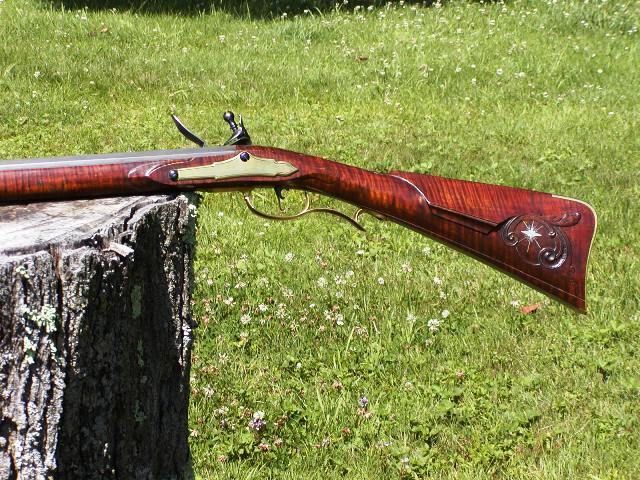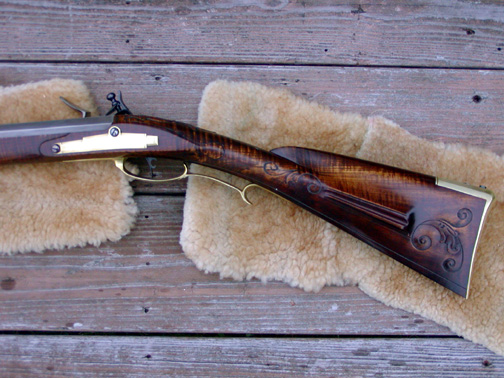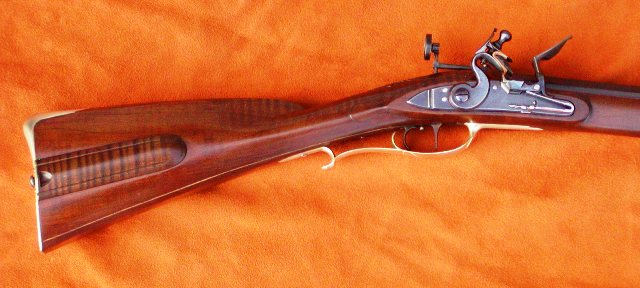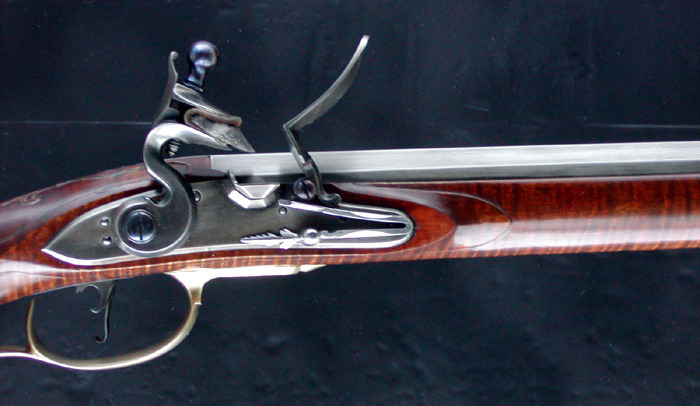Every piece of wood stains differently with ferric nitrate. I use test pieces. Red maple is more yellow/brown/black or what I call honey and molasses in tone. Sugar maple gives the more reddish colors. Start dilute and so on if doing it yourself. But I don’t tell a master builder what they should try.
You are using an out of date browser. It may not display this or other websites correctly.
You should upgrade or use an alternative browser.
You should upgrade or use an alternative browser.
Of what style is a Kibler Colonial Rifle?
- Thread starter GAHUNTER60
- Start date

Help Support Muzzleloading Forum:
This site may earn a commission from merchant affiliate
links, including eBay, Amazon, and others.
Every piece of wood stains differently with ferric nitrate. I use test pieces. Red maple is more yellow/brown/black or what I call honey and molasses in tone. Sugar maple gives the more reddish colors. Start dilute and so on if doing it yourself. But I don’t tell a master builder what they should try.
Gotcha, yeah it will be a few months before it arrives, and I'll ask him what he recommends and if we can somehow do it without breaking history too much. Its going to be a wall hanger for certain and we were hoping for more of a light color to fit. Anything other than chocolate browns is okay by me. He was willing to dye it but I know it probably was hurting his soul to offer it haha.
APG
45 Cal.
If you can't dazzle them with brilliance, then baffle them with BS.I think I'll go with "It's a copy of a style built in the Shenandoah Valley, specifically three shops outside of Staunton, Virginia, circa 1760 to 1767. Not to be confused with James River styles built in the same period!"
How's that sound?
As I learned from the great Sheldon Cooper, the believability of a lie is directly correlated to the amount of unverifiable detail associated with it. Of course, the information contained in my lie is verifiable to an expert on the history of American longrifles, but I'm betting the folks asking about mine are not of this ilk.
Last edited by a moderator:
- Joined
- Nov 1, 2018
- Messages
- 3,884
- Reaction score
- 2,914
It closely resembles an early Virginia Long Rifle with some Lancaster characteristics In the forearm. The Long PA Virginia Maryland Border saw a lot of trading between gunsmiths of that 1760’s -1770’s era. Kibler‘s rifle is very period correct for American Revolutionary War.
- Joined
- Nov 26, 2005
- Messages
- 5,229
- Reaction score
- 10,903
Hi,
"I'm having a Kibler built and the builder was talking about only using Iron Nitrate (Which always ends up in a brown/gold color at the end) when I'm kind of wanting a custom to have more of a red maple look to it. "
Here is ferric nitrate on red maple. Always brown-gold, really?

Here is ferric nitrate on sugar maple.




If I knew it would only be a brown-gold color I wouldn't have used it on those rifles.
dave
"I'm having a Kibler built and the builder was talking about only using Iron Nitrate (Which always ends up in a brown/gold color at the end) when I'm kind of wanting a custom to have more of a red maple look to it. "
Here is ferric nitrate on red maple. Always brown-gold, really?

Here is ferric nitrate on sugar maple.




If I knew it would only be a brown-gold color I wouldn't have used it on those rifles.
dave
- Joined
- Nov 26, 2005
- Messages
- 5,229
- Reaction score
- 10,903
Hi,
"The problem with modern day replicas of colonial long rifles I think we tend to overly rely on the english round faced lock."
We do??




Now, what IS true is builders rely too much on round faced English locks for their English fowlers even when their gun represents a time when round-faced locks were only used on military, livery, and cheap trade guns.
dave
"The problem with modern day replicas of colonial long rifles I think we tend to overly rely on the english round faced lock."
We do??




Now, what IS true is builders rely too much on round faced English locks for their English fowlers even when their gun represents a time when round-faced locks were only used on military, livery, and cheap trade guns.
dave
Last edited:
- Joined
- Nov 1, 2018
- Messages
- 3,884
- Reaction score
- 2,914
Hi,
"The problem with modern day replicas of colonial long rifles I think we tend to overly rely on the english round faced lock."
We do??




Now, what IS true is builders rely too much on round faced English locks for their English fowlers even when their gun represents a time when round-faced locks were only used on military, livery, and cheap trade guns.
dave
A lot of the VA, MD and PA longrifle builds I’ve seen at Dixons tend to use the round faced lock, that’s just my observation. It could be a Jim Chambers preference on quality and availability, which I would agree, his locks are very good when compared to L&R and Davis. In my reenactment group I always come across that lock too on guns used in rifle men units and ranger units.
I haven’t seen too many fowlers other than Track’s kits and a few TVM. I think TVM uses both the round faced lock and the Larger colonial lock by l&R.
- Joined
- Nov 26, 2005
- Messages
- 5,229
- Reaction score
- 10,903
Hi,
All seriousness aside, if you go to the link below you'll see what may be Jim's prototype for his colonial rifle.:
https://www.jimkibler.net/rifle-4.html
I remember him posting it on the ALR sight some years ago. I think he had recently completed a superb English fowler based on an original by Harman and you can see some of that influence in the rifle. I think it could easily be construed as Virginia. It also reminds me a little of the famous Albrecht rifle made when he lived in Lititz, PA. It likely would be from the 1770s.
dave
All seriousness aside, if you go to the link below you'll see what may be Jim's prototype for his colonial rifle.:
https://www.jimkibler.net/rifle-4.html
I remember him posting it on the ALR sight some years ago. I think he had recently completed a superb English fowler based on an original by Harman and you can see some of that influence in the rifle. I think it could easily be construed as Virginia. It also reminds me a little of the famous Albrecht rifle made when he lived in Lititz, PA. It likely would be from the 1770s.
dave
- Joined
- Nov 1, 2018
- Messages
- 3,884
- Reaction score
- 2,914
Hi,
All seriousness aside, if you go to the link below you'll see what may be Jim's prototype for his colonial rifle.:
https://www.jimkibler.net/rifle-4.html
I remember him posting it on the ALR sight some years ago. I think he had recently completed a superb English fowler based on an original by Harman and you can see some of that influence in the rifle. I think it could easily be construed as Virginia. It also reminds me a little of the famous Albrecht rifle made when he lived in Lititz, PA. It likely would be from the 1770s.
dave
were any colonial rifles half octagon to round barreled ? I know modern fowlers are rifles but was always under the impression that was a modern improvement
smoothshooter
50 Cal.
Unless a rifle of “colonial” styling is based on originals known to be from a specific geographical area, nobody knows where it was made. There are a lot of guns out there with nothing but speculation on where and when they were made. It seems like Jim Kibler deliberately did not base his colonial rifle on originals known to be from Pennsylvania assigned to a particular “school”. Definitely not Lancaster, Berks, Northampton, Allentown/Bethlehem/Christians Spring. Keep in mind that just about all colonial Virginia-attributed rifles except the Haymaker are just that- attributed, unsigned, best guesses.
Gunsmiths and apprentices moved around, and undoubtedly did several different styles depending on what the customer wanted.
I have a hard time believing that someone in the business of gun-making only made one style, and no other.
If two guys walked into a gunsmith’s shop in central Pennsylvania in 1772, and one said “ I want you to make me a gun just like the one my friend Jake here has. A guy down in Maryland made it for him last year.”, I’ll bet he would have a new gun to pick up in a few weeks.
That is not to say that the owner of the gun shop might not try to talk the prospective customer into buying something that was already finished and on hand, or buying a style that that particular gunsmith thought was the ideal / ultimate in rifle design ( that he preferred to build ).
My point is that a lot of those guys could and did build more than one style of gun; the same as Dave Person, Wallace Gusler, Danny Caywood and others could do in our own time.
Sometimes it’s best not to get too hung up on overly rigid definitions of style on these things.
Smooth shooter, have you studied the work of well known colonial gunsmiths? The idea that gunsmiths made whatever the customer ordered has no data to support it. It’s a popular modern notion I hear often. Let’s see one example of a signed 1760-1790 rifle by a maker with a recognizable style, made in a different style. Let’s see a JP Beck, a Christian Oerter, a John Bonewitz, an Amstrong, a Sell, a Schroyer, a Neihardt, and so on, that they made and signed, which is not in their primary style, and IS made in a recognizable style from another maker or geographical area. There are documented instances of a gunsmith moving to a new gun making center and adopting the local style. Andreas Albrecht adopted a Lancaster style when he moved to Lancaster. That’s a far cry from making whatever any customer that wandered in desired.
The idea that a gunsmith would make whatever style a customer wanted has several underlying assumptions:
1) The shop was not busy with orders in its usual style.
2) The shop somehow imagined that making wooden prototypes to use for casting new style guards and buttplates would be sensible, economically.
3) The customer was not sensible enough to go where guns he liked were made.
4) The customer was stuck on a style. And he already had a gun in that style. Otherwise his would the gunsmith know exactly what it looked like?
I could go on. But I am easily convinced by data.
The idea that a gunsmith would make whatever style a customer wanted has several underlying assumptions:
1) The shop was not busy with orders in its usual style.
2) The shop somehow imagined that making wooden prototypes to use for casting new style guards and buttplates would be sensible, economically.
3) The customer was not sensible enough to go where guns he liked were made.
4) The customer was stuck on a style. And he already had a gun in that style. Otherwise his would the gunsmith know exactly what it looked like?
I could go on. But I am easily convinced by data.
Here is ferric nitrate on red maple. Always brown-gold, really?
dave
Is Ferric nitrate the same as Iron Nitrate? I'm just repeating what I was told. I would love to get that stump picture color. I'll talk to my builder if its possible with traditional means.
Also I have "Fancy Maple" which I'm not sure is Sugar maple. I was told you get what you get with color.
- Joined
- Nov 26, 2005
- Messages
- 5,229
- Reaction score
- 10,903
Hi Osseon,
Let me clear up any confusion you might have. Ferric nitrate is iron nitrate. There is a traditional stain called "aqua fortis" that was and still is used on maple stocked guns. Aqua fortis stain is iron dissolved in nitric acid making ferric nitrate. Today many makers use the same stuff but make it not from dissolving iron in acid but from ferric nitrate crystals, which you can buy from chemistry supply stores. When the crystals are dissolved in water, they make essentially aqua fortis but without the strong acid base. These stains work by actually oxidizing the wood allowing the iron oxide (rust) to bond with the wood fibers. When painted on the wood and let dry, the stain often looks ugly and gray. Then heat is applied and the acid ions are driven off and the iron blushes into various colors of reddish- golden-brown. The red colors depend on the wood and the amount of iron in the stain. A great feature of aqua fortis or ferric nitrate stain is it is totally color fast and will never fade in sunlight or UV light.
There are 3 species of maple commonly used for stocks, sugar maple, black maple, and red maple. The hardest and densest usually is sugar maple with black about the same. Red maple tends to be a little softer. All of these species can have figure and curl. Red maple often has more vivid curl or "tiger" striping but it is softer and does not support carved detail as well (being softer it crushes, dents, or chips away easier). Black and sugar maple can also have bright curl and figure, and usually are better to carve because the strong wood preserves details more readily. When a supplier sells "fancy" maple he must simply be referring to the amount of figure and curl, not the species. If he says fancy hard maple, the blank is probably sugar or black maple. If he just refers to it as "fancy', you don't really know what it is.
dave
Let me clear up any confusion you might have. Ferric nitrate is iron nitrate. There is a traditional stain called "aqua fortis" that was and still is used on maple stocked guns. Aqua fortis stain is iron dissolved in nitric acid making ferric nitrate. Today many makers use the same stuff but make it not from dissolving iron in acid but from ferric nitrate crystals, which you can buy from chemistry supply stores. When the crystals are dissolved in water, they make essentially aqua fortis but without the strong acid base. These stains work by actually oxidizing the wood allowing the iron oxide (rust) to bond with the wood fibers. When painted on the wood and let dry, the stain often looks ugly and gray. Then heat is applied and the acid ions are driven off and the iron blushes into various colors of reddish- golden-brown. The red colors depend on the wood and the amount of iron in the stain. A great feature of aqua fortis or ferric nitrate stain is it is totally color fast and will never fade in sunlight or UV light.
There are 3 species of maple commonly used for stocks, sugar maple, black maple, and red maple. The hardest and densest usually is sugar maple with black about the same. Red maple tends to be a little softer. All of these species can have figure and curl. Red maple often has more vivid curl or "tiger" striping but it is softer and does not support carved detail as well (being softer it crushes, dents, or chips away easier). Black and sugar maple can also have bright curl and figure, and usually are better to carve because the strong wood preserves details more readily. When a supplier sells "fancy" maple he must simply be referring to the amount of figure and curl, not the species. If he says fancy hard maple, the blank is probably sugar or black maple. If he just refers to it as "fancy', you don't really know what it is.
dave
Funny story on sugar vs red maple. I was at an event where a vendor had a lot of beautiful maple blanks. They were marked in pencil with price, thickness, and “S” or “H”. I was having a brain freeze and thought the S meant “sugar”. It meant soft and “H” meant heavy.
If he says fancy hard maple, the blank is probably sugar or black maple. If he just refers to it as "fancy', you don't really know what it is.
dave
Its a Kibler, he doesn't really list what kind is on his site, though I've seen people refer to it as red or sugar.
- Joined
- Nov 26, 2005
- Messages
- 5,229
- Reaction score
- 10,903
Hi Osseon,
I don't know how Jim grades or chooses his wooden blanks. However, I am sure every blank is hard because he likely needs that density to withstand his CNC machining and keep the "snap together" feature of his kits. You can find red maple blanks that are very hard and dense, almost equivalent to sugar maple but many are considerably softer. Nonetheless, you can be assured that Jim has very high standards and any blank, red, sugar, or black maple, is going to be of good wood for stocks.
dave
I don't know how Jim grades or chooses his wooden blanks. However, I am sure every blank is hard because he likely needs that density to withstand his CNC machining and keep the "snap together" feature of his kits. You can find red maple blanks that are very hard and dense, almost equivalent to sugar maple but many are considerably softer. Nonetheless, you can be assured that Jim has very high standards and any blank, red, sugar, or black maple, is going to be of good wood for stocks.
dave
- Joined
- May 6, 2014
- Messages
- 17,439
- Reaction score
- 16,440
were any colonial rifles half octagon to round barreled ? I know modern fowlers are rifles but was always under the impression that was a modern improvement
I'm going to answer with a "cautionary Yes," because there is one on display at the Valley Forge Visitors Center, that is supposed to be a Virginia made Rifle used during the AWI. It is a rather strange rifle, though.
It has what appears to be a much older Dutch or possibly French Lock on it with the recognizable teat on the rear of the lock plate. The brass patch box is rather complex for the period, as far as I know. It has keys affixing the barrel to the stock, rather than pins. So it is a mix of a very old lock with some rather "most up to date" features for a rifle of that period.
I did ask and got with the Curator and they had NO additional information on that rifle.
I have not checked RCA Volumes I and II, so there may be other examples of octagon to round barreled rifles in those books.
Gus
Brokennock
Cannon
An excellent reply over all.Smooth shooter, have you studied the work of well known colonial gunsmiths? The idea that gunsmiths made whatever the customer ordered has no data to support it. It’s a popular modern notion I hear often. Let’s see one example of a signed 1760-1790 rifle by a maker with a recognizable style, made in a different style. Let’s see a JP Beck, a Christian Oerter, a John Bonewitz, an Amstrong, a Sell, a Schroyer, a Neihardt, and so on, that they made and signed, which is not in their primary style, and IS made in a recognizable style from another maker or geographical area. There are documented instances of a gunsmith moving to a new gun making center and adopting the local style. Andreas Albrecht adopted a Lancaster style when he moved to Lancaster. That’s a far cry from making whatever any customer that wandered in desired.
The idea that a gunsmith would make whatever style a customer wanted has several underlying assumptions:
1) The shop was not busy with orders in its usual style.
2) The shop somehow imagined that making wooden prototypes to use for casting new style guards and buttplates would be sensible, economically.
3) The customer was not sensible enough to go where guns he liked were made.
4) The customer was stuck on a style. And he already had a gun in that style. Otherwise his would the gunsmith know exactly what it looked like?
I could go on. But I am easily convinced by data.
This part stands out to me as it is customer based and seems unlikely during the period....
I have a hard time accepting that the average gun buyer in the 18th century, excluding the very wealthy, would travel all that far just to get a gun of a different shape than was made locally. I can see one traveling a little ways to get one built by a builder of a known quality reputation, but still not going all that far.3) The customer was not sensible enough to go where guns he liked were made.
Might he trade or barter for something he liked the look of and saw it shoot well when and if someone came around with something different? Probably. Might he trade for or buy something that was made several states away of he was somehow without his gun and an interesting well made gun was available,, I'm sure.
Go from Lancaster to Williamsburg just to buy a rifle,,, I find it doubtful.
Brokennock, among my collected articles is one of a Hawken rifle ordered by and delivered to a customer in New York state. I also believe J P Beck made a rifle for George Washington. But as we know George got around quite a bit and slept just about everywhere so he may have visited Lebanon PA for all I know. These are rare and notable happenings.
Similar threads
- Replies
- 60
- Views
- 3K
- Replies
- 28
- Views
- 976
- Locked
SOLD - Pending funds
Bruce Hamlin .45, 38" Swamped Rice Barrel, Round Bottom Rifling: $1,450
- Replies
- 7
- Views
- 1K
- Replies
- 28
- Views
- 3K




